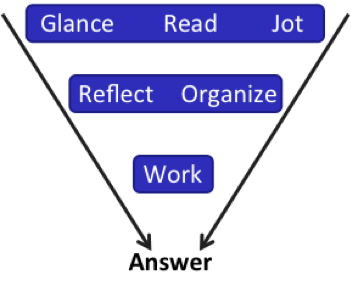-
Target Test Prep 20% Off Flash Sale is on! Code: FLASH20
Redeem
GMAT Data Sufficiency: Follow Your Process - Part 2
 In the first installment of this series, we talked about an overall process that allows you to work methodically and make sure that youre performing the necessary analysis to give yourself the best shot at answering the question correctly (avoiding traps and careless mistakes).
In the first installment of this series, we talked about an overall process that allows you to work methodically and make sure that youre performing the necessary analysis to give yourself the best shot at answering the question correctly (avoiding traps and careless mistakes).
First glance at the problem to see what youve got. Consciously notice whether its Problem Solving (PS) or Data Sufficiency (DS). (Seriously! Your whole mindset changes depending on which type it is, so notice.) Also note where the complexity seems to lie. Anything ugly in the question stem? In the statements? Both?
As you read, jot down any important information. Dont do anything with it yet; you are not solving. The word jot was chosen deliberately: just get the info down on paper.
Next, still dont start solving. :) Give yourself a little time to look at what youve got and think about what they could tell you that would be sufficientand what would not be sufficient. (In other words, reflect!) If applicable, organize or combine information that you already know in order to simplify or rephrase the question. Decide how youre going to tackle the problem.
Finally, you can start solvingassuming you made it through the first two rows successfully. If you dont actually Understand (the goal of row 1) or you havent come up with a good Plan (the goal of row 2), then dont continue to work on the problem. Trying to solve without a good understanding of the problem or a good plan is a waste of precious time.
Everything weve talked about so far can apply to any problem on the GMAT. Today, were going to add a few more process layers that are specific to DS.
You ready to try another problem? Here you go. (This one is from the free GMATPrep exams.)
*Is the average (arithmetic mean) of 5 different positive integers at least 30?(1) Each of the integers is a multiple of 10.
(2) The sum of the 5 integers is 160.
(I again havent listed the answer choices here; if you havent done enough DS to know what the answer choices are, then dont start with this series. Start here.)
Got your answer? Okay, lets get started.
Glance at the problem. Its DS! Draw a T on your scrap paper and jot down the relevant info as you read.
Why do I draw things out that way? Its really important to separate the information given in a DS problem into one of three categories:
- The question stem
- Statement (1)
- Statement (2)
Info in the question stem applies to both statements. Statements (1) and (2), however, are distinct. You have to keep them completely separate at first; later in the problem, you might have to put those two statements together, but youre not allowed to do that at first.
Time for step 2: reflect and organize. Whats the significance of the information given in the question stem?
These 5 numbers are positive. Theyre integers. And theyre different from one another. Make sure your scrap paper reflects every last detail of that info.
Next, the stem mentions average. When a problem mentions something for which you know a formula, jot it down. Plug in what you know.
Check it out. If the average is at least 30, then the sum is at least 150. So if they tell you the average, that would be sufficient to answerbut they could also tell you something about the sum. (This is what we call rephrasing the question, by the way.)
If the average > 30, then the answer is Yes. If the average is < 30, the answer is No. Either way, that information is Sufficient. If, on the other hand, the average is a range that crosses that threshold, the answer is Maybe and the information is Not Sufficient.
Likewise, if the sum is > 150, the answer is Yes (= Sufficient). If the sum is < 150, the answer is No (= Sufficient). If the sum is a range that crosses that threshold, the answer is Maybe (= Not Sufficient).
Great. Lets work this thing. Glance at those statements. Any preference where to start?
Now that weve rephrased the question, definitely start with statement 2. :)
(2) The sum of the 5 integers is 160.
Boom. Sum is greater than 150. Thats sufficient. Cross off ACE. See how useful it was to take the time to rephrase the question?
Moving on to statement (1).
(1) Each of the integers is a multiple of 10.
At first glance, this one doesnt look all that useful. Remind yourself of the constraints given in the question stem. Each number is a different positive integer.
Test a Case. What are the smallest values that will still fit the criteria?
10, 20, 30, 40, 50
In this case, the sum islets see, its a consecutive set, and there are an odd number of terms, so the average is just the middle number, 30.
So for this case alone, the answer is Yes, because the average is > 30.
Whats the next step in the Testing Cases process? Your goal is to try to disprove the statement (if you can!), so try to get the opposite answer. Can you get a No?
Its impossible to get a No answer. Why?
The first Case represented the smallest possible set, so any other set will include at least one larger number. The smallest possible set already averaged to 30, so any other set will average to more than 30.
This statement is Always Yes, which is Sufficient to answer the question.
The correct answer is (D).
Key Takeaways for Data Sufficiency:
(1) Your first goal is to Understand. See what the moving parts are. Jot everything down.
(2) Dont solve yet. First, come up with a Plan. Most of the time, Data Sufficiency questions are hiding something of relevance. Unless the question is very simple / straightforward, theres probably something you could figure out before you go to the statements that will really speed up your processing of the statements. Look for those opportunities to rephrase or simplify the question.
(3) You can Solve now. When solving, its often useful to Test Cases, especially on Yes/No DS questions. When you do this, remember that you have to test more than one case. After you test your first case, your goal is to try to get the opposite answer (Yes No or No Yes) for your second case. If you can find both a Yes and a No, that statement is Not Sufficient. If you have an Always Yes or Always No situation, then that statement is Sufficient.
* GMATPrep questions courtesy of the Graduate Management Admissions Council. Usage of this question does not imply endorsement by GMAC.
Recent Articles
Archive
- May 2024
- April 2024
- March 2024
- February 2024
- January 2024
- December 2023
- November 2023
- October 2023
- September 2023
- July 2023
- June 2023
- May 2023
- April 2023
- March 2023
- February 2023
- January 2023
- December 2022
- November 2022
- October 2022
- September 2022
- August 2022
- July 2022
- June 2022
- May 2022
- April 2022
- March 2022
- February 2022
- January 2022
- December 2021
- November 2021
- October 2021
- September 2021
- August 2021
- July 2021
- June 2021
- May 2021
- April 2021
- March 2021
- February 2021
- January 2021
- December 2020
- November 2020
- October 2020
- September 2020
- August 2020
- July 2020
- June 2020
- May 2020
- April 2020
- March 2020
- February 2020
- January 2020
- December 2019
- November 2019
- October 2019
- September 2019
- August 2019
- July 2019
- June 2019
- May 2019
- April 2019
- March 2019
- February 2019
- January 2019
- December 2018
- November 2018
- October 2018
- September 2018
- August 2018
- July 2018
- June 2018
- May 2018
- April 2018
- March 2018
- February 2018
- January 2018
- December 2017
- November 2017
- October 2017
- September 2017
- August 2017
- July 2017
- June 2017
- May 2017
- April 2017
- March 2017
- February 2017
- January 2017
- December 2016
- November 2016
- October 2016
- September 2016
- August 2016
- July 2016
- June 2016
- May 2016
- April 2016
- March 2016
- February 2016
- January 2016
- December 2015
- November 2015
- October 2015
- September 2015
- August 2015
- July 2015
- June 2015
- May 2015
- April 2015
- March 2015
- February 2015
- January 2015
- December 2014
- November 2014
- October 2014
- September 2014
- August 2014
- July 2014
- June 2014
- May 2014
- April 2014
- March 2014
- February 2014
- January 2014
- December 2013
- November 2013
- October 2013
- September 2013
- August 2013
- July 2013
- June 2013
- May 2013
- April 2013
- March 2013
- February 2013
- January 2013
- December 2012
- November 2012
- October 2012
- September 2012
- August 2012
- July 2012
- June 2012
- May 2012
- April 2012
- March 2012
- February 2012
- January 2012
- December 2011
- November 2011
- October 2011
- September 2011
- August 2011
- July 2011
- June 2011
- May 2011
- April 2011
- March 2011
- February 2011
- January 2011
- December 2010
- November 2010
- October 2010
- September 2010
- August 2010
- July 2010
- June 2010
- May 2010
- April 2010
- March 2010
- February 2010
- January 2010
- December 2009
- November 2009
- October 2009
- September 2009
- August 2009
